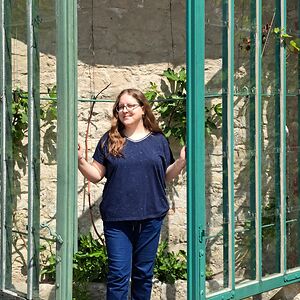
Couple Doesn’t Shy Away From Sharing Details Of Their Life Off-Grid In A Yurt They Built Themselves
While some people love living in a big city, for others, such a lifestyle isn’t what they dream of. And it’s completely normal; we all were raised in different conditions, with different ideals, and our brains are simply wired differently.
Jill and Charles are those people who don’t like the rush of the big cities. So, they saved up money and moved into rural Vermont, where they now live in nature and among wild animals. What’s even more interesting is that their home is a completely off-grid yurt, which gives them independence others only dream of.
More info: YouTube
While some people love living in a rush of a big city, others prefer the quieter lifestyle
Image credits: Exploring Alternatives
Jill and Charles are a couple who live off-grid in rural Vermont, where they own land
In a modern world, we’re lucky enough to have a chance to pick what lifestyle we want to live by, and the choices are numerous. After doing the simplest Google search, we came across a list of over 101 lifestyle examples, so there is more than enough for anyone to choose from.
This list includes more familiar examples like minimalism and veganism to less common ones like ski bum (prioritizing skiing or snowboarding over traditional careers) or occultism (exploring secret or esoteric knowledge like alchemy, divination, spirituality, or supernatural phenomena).
Image credits: Exploring Alternatives
It also includes the off-grid living example we’re focusing on today. Typically, when people live off-grid, it means their home isn’t physically hooked up to utilities by wires, pipes, or cables and relies on their own energy sources—more often than not, renewable ones, like the sun and the wind.
Jill and Charles from the YouTube channel @OvertheRiverandThroughtheWoods are one of these people. This channel was created back in 2021, and ever since, it has gained over 6K followers with 130 videos.
In it, the couple shares the ins and outs of their life off-grid in rural Vermont, where they own land. They arrived there a few years ago in a travel trailer and slowly started setting up their own systems and building their house—a 30-foot Pacific Yurt, which they bought from a kit.
Image credits: Exploring Alternatives
Their house is a DIY Pacific Yurt, which is more fancy than some of the more usual houses
Such yurt is an adaptation of the shelters Central Asian nomads used to have. So, don’t think that they’re living in a simple tent-like home; in reality, it’s way more modern than some of the more usual houses. It has a deck, windows, insulation, a heating system, a bathroom, and even a skylight. Basically, everything (if not more) you need for a perfect little house, and a lot of it was built by Charles’ hands.
Additionally, since their home is off-grid, it has a solar power and rain collection system, which, as they said, makes them more aware of their consumption and what resources they need to live.
Image credits: Exploring Alternatives
Jill and Charles ending up here wasn’t just a coincidence. As the couple revealed in the video on the Exploring Alternatives YouTube channel, Charles wanted to build an off-grid home for a long time. He grew up in the countryside, and even living in the city didn’t crush his country spirit; it only became a means to an end to achieving the desired lifestyle.
Jill was also eager to live this way, as she wanted to be near nature, live among bobcats, bears, and other wild animals, and hear birds instead of city noises—you get the gist.
Image credits: Exploring Alternatives
They installed all systems like solar, water collection, and everything else that lets them live off-grid themselves, which took quite a long time
As with everything in life, even the realized dreams have some cons to them. In Jill and Charles’ case, one of them was that building everything wasn’t cheap – purchasing the yurt’s kit, installing all the systems, and similar things ended up costing a pretty penny — the yurt itself cost around $30K. Plus, it took quite a long time to finish everything and move in.
Now, when they live there, in summer, the yurt collects the heat just like the greenhouse, but luckily, Charles was able to find at least a temporary solution for it so their home would be liveable.
Image credits: Exploring Alternatives
Despite all of these disadvantages, some pros make it all worth it. While it costs much to build everything, now they have minimal expenses, have no debts, and don’t feel pressure to earn money. This not only makes them feel independent but also lets them use their time for activities they’re passionate about, like documenting life on a YouTube channel, which is a good source of information for those who are thinking about doing something similar.
While currently, the number of subscribers isn’t the highest, their videos still get some attention and praise from interested people, and sometimes being acknowledged is everything you need. You can also go check out their channel, and maybe you’ll be inspired to alter your lifestyle this way, too.
While there are some disadvantages to living this way, the pros are outweighing them and people online couldn’t be happier for them
If I had the opportunity I might like to live this life, but I worry I might yurt myself.
We have a week in the summer in a yurt, great fun, but I think winter would break me
I knew a couple who did something similar - but instead of a yurt, they built a Venda-style hut for their farmhouse. It was round, divided into 4 rooms, with a thatched roof. Very cool design.
If I had the opportunity I might like to live this life, but I worry I might yurt myself.
We have a week in the summer in a yurt, great fun, but I think winter would break me
I knew a couple who did something similar - but instead of a yurt, they built a Venda-style hut for their farmhouse. It was round, divided into 4 rooms, with a thatched roof. Very cool design.

 Dark Mode
Dark Mode 

 No fees, cancel anytime
No fees, cancel anytime 
















































35
5